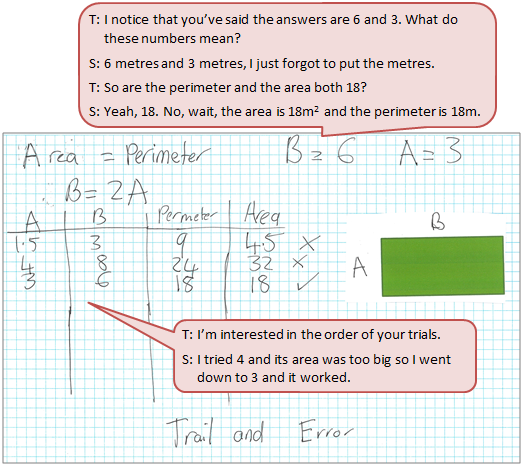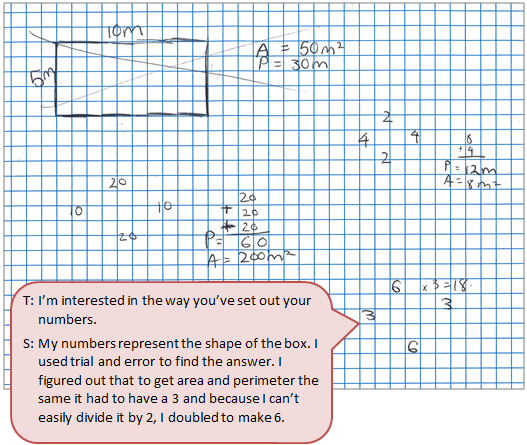The purpose of this activity is to engage students in finding unknown quantities that fit within the given constraints.
This activity assumes the students have experience in the following areas:
- Finding the perimeter and areas of rectangles.
- Comparing values to get optimal solutions.
The problem is sufficiently open ended to allow the students freedom of choice in their approach. It may be scaffolded with guidance that leads to a solution, and/or the students might be given the opportunity to solve the problem independently.
The example responses at the end of the resource give an indication of the kind of response to expect from students who approach the problem in particular ways.

A rectangular lawn space has long sides twice the length of the short sides.
Its area, in m², is the same number as the perimeter in m.
What are the possible dimensions of the field?
The following prompts illustrate how this activity can be structured around the phases of the Mathematics Investigation Cycle.
Make sense
Introduce the problem. Allow students time to read it and discuss in pairs or small groups.
- Do I understand the situation and the words? (Students may need support to understand the meaning of dimensions, perimeter and area, and the units of measurement involves, especially square metres (m2).
- What is fixed and what can vary in the problem? (The side lengths and areas can vary but the relationship between area and perimeter remains invariant.)
- What will my solution look like? (The solution will be a shortest side length that meets the conditions.)
Plan approach
Discuss ideas about how to solve the problem. Emphasise that, in the planning phase, you want students to say how they would solve the problem, not to actually solve it.
- How will I represent this problem using numbers, pictures, graphs, tables, or materials?
- What strategies can I use to get started? What strategies will be most useful? (A table of results is important so any pattern is visible?
- What measurements for side lengths should I begin with? Why?
- Do I have a sense of a side length that might work?
- What effect will adding, or subtracting, a metre from the shortest side have on the area? How do I know?
Take action
Allow students time to work through their strategy and find a solution to the problem.
- Is my working recorded in an organised way so any patterns are visible?
- What patterns do I see?
- How might I describe the pattern?
- How do the patterns help me find the solution?
- Does my solution make sense? Does it match the area = perimeter condition?
- Is there another possible answer or way to solve it? How can I be sure?
Convince yourself and others
Allow students time to check their answers and then either have them pair share with other groups or ask for volunteers to share their solution with the class.
- How would I convince someone else I am correct?
- Could I have solved the problem in a more efficient way?
- What would happen to my solution if one of the conditions changed?
- Does my solution seem reasonable in context?
- Which ideas or tools worked well in my investigation?
- What could I try differently next time?
Examples of work
Work sample 1
The student solves the area problem, with guidance.
Click on the image to enlarge it. Click again to close.
Work sample 2
The student solves the area problem, independently.

